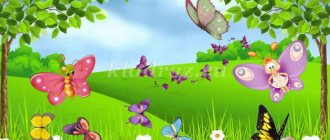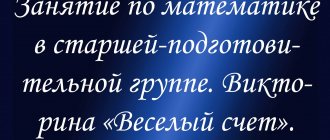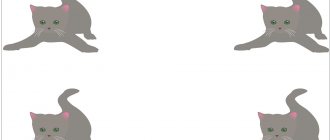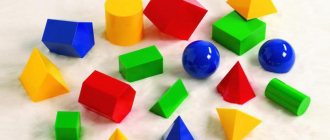Notes on mathematics in the preparatory group of preschool educational institutions. Count within 10
Summary of a mathematics lesson in the preparatory group “Journey to the Queen of Numbers.”
Author: Alexandra Nikolaevna Smirnova, teacher at MBDOU “Kindergarten No. 104”, Ivanovo
Lesson topic: “Journey to the Queen of Numbers.”
Goals : To consolidate the ability to use quantitative and ordinal counting within 10. Objectives: Educational:
• - Practice counting within 10 in forward and reverse order;
• — consolidate the concepts: “previous”, “next”, “neighbors” of the named number; • — Consolidate knowledge about the sequence of days of the week and seasons. Developmental:
• develop attention, imagination, creativity, speech.
Educational:
• - Cultivate a friendly attitude towards each other, a sense of mutual assistance.
• — To develop independence, the ability to understand a learning task and carry it out independently. • — Cultivate interest in mathematical studies. Preliminary work with children: • Guessing riddles, solving logical problems, solving simple arithmetic problems. Equipment: - cards with tasks, a checkered sheet of paper and a pencil according to the number of children, counting sticks, a chest with a surprise.
Course of the lesson:
Educator: Do you guys like traveling? (Children's answers). Today we will go on a journey to the Queen of Numbers. She needs our help, because evil robbers have stolen 3 numbers. Shall we help the Queen find them? (children's answers). Interesting tasks will await us. You will have to show your knowledge, skills and intelligence. Are you ready to go on this exciting journey? (children's answers) Educator: Well done! And now you will find out how we will get there. Guys, each of you has a sheet of paper with dots and numbers on your table. Your task is to connect the numbers in the correct order. (train)
What did you get? (compare with a board). Well done! Let's go on a trip. Guys, while you and I are on the train to the Queen of Numbers, let's tune in and practice. Let's get ready? First, let's remember: - Guys, what day of the week is it today? (Thursday) - What day of the week was yesterday? (Wednesday) - What day of the week will it be tomorrow? (Friday) - How many days are there in the week? (seven) - What days are the weekends? (Saturday and Sunday) How many seasons are there (4) How many months does each season have (3) How many months are there in the year (12) Now, I will name a number of words, and you will have to name the extra word. Winter, Wednesday, spring, summer, autumn (Wednesday) One, two, three, circle, four (circle) Plus, minus, Friday, equal (Friday) And now I will ask questions, listen carefully. If the table is higher than the chair, then the chair? (Below the table) If the road is wider than the path, then is it a path? (Already roads) If the ruler is longer than the pencil, then the pencil? (Shorter than a ruler) If the rope is thicker than the thread, then the thread? (Thinner than a rope) If a sister is older than a brother, then is the brother? (Younger than sister) Educator: Well done guys! Well, here we are. See the letter here. Let's read it. "Letter. Dear Guys! I have a problem, evil robbers stole my numbers, without them I can’t build a number series, I hope that you will help me find the missing numbers. The robbers have prepared tasks for you and said that for each correct solution of the tasks they will return numbers. I hope for your help, I can’t do it alone.” Educator: Guys, can we help the Queen? (children's answers) And so, the first task: The robbers have prepared problems for us, let's solve them: A puppy is sitting on the porch, warming his fluffy side. Another one came running and sat down next to him. How many puppies are there? (2) Antoshka fell into the snow, followed by Irinka. And behind her is Seryozhka, and behind him is Marinka. And then Ignat fell. How many children are there in the snow? (5) Grandma Masha has a grandson, Fyodor the Cat Pushok. Dog Buddy. How many grandchildren does grandma have? (1) 4 birds are sitting on a tree: 2 sparrows, the rest are crows. How many crows? (2) There were 6 mushrooms in the basket, 1 mushroom turned out to be inedible and was thrown away. How many mushrooms are left? (5) 5 roses bloomed on the bush. Mom cut 3 pieces, how many are left? (2) There were 5 red cups and 1 blue cup on the shelf. How many cups were there? (6) There are 8 tomatoes ripe on the bush. Four tomatoes were picked. How much is left? (4) Educator: Guys, it says here that if we solve the last problem correctly, we will get the first number that was stolen by the robbers. Listen carefully. Mom put cabbage pies in the oven. For Natasha, Kolya, Vova, the pies are already ready, and the cat dragged one more pie under the bench. Moreover, Mom needs to take five out of the oven. If you can, help - Count the pies! (9) Educator: Well done guys, you completed this task, and the robbers return one number to us. Now let's rest a little and move on. Physical education lesson: Let's jump and gallop! One two three four five! Let's jump and jump! (Jumping in place.) The right side bent. (Tilts the body left and right.) One, two, three. Left side bent. One two Three. Now let’s raise our hands (Hands up.) And reach for the cloud. Let's sit on the path, (Sit down on the floor.) We'll stretch our legs. Let's bend our right leg, (Bend our legs at the knee.) One, two, three! Let's bend the left leg, One, two, three. They raised their legs high (Raised their legs up.) And held them for a while. They shook their heads (Move their heads.) And everyone stood up together. (They stood up.) Educator: Well, you and I have had a little rest, we need to move on. Look at the tables, the robbers have prepared another task for you, if you solve it correctly, they will return another number to us. Ready? (children's answers) “Composition of numbers.” Guys, each of you has pictures of houses, in each house there are as many residents as are indicated on the roof, for example, 7 residents live in a house, 5 have already moved in, how many people will live in another apartment? (2). Guys, do you understand the task? (children's answers). Children complete tasks, composition of numbers.
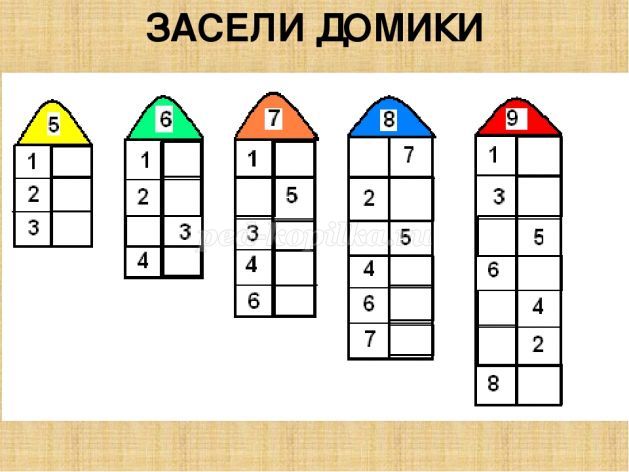
Educator : Well done guys, you completed this task too, the robbers are returning another number to us. Warm-up: Now all the children should stand up, slowly raise their hands, clench their fingers, then unclench their hands, hold their hands down and stand like that. We all rested a little (lean forward and shake our arms) and went on the path. (steps in place or in a circle) Educator: Guys, we have already returned two numbers to the Queen of Numbers, we have one last task left, is everyone ready to cope with it? (children's answers) Look at the geometric shapes on our table, we need to build a house from them, but not just build, first we need to guess, and only then build our house. 1. Four corners and four sides, They look exactly like sisters. You can’t roll him into the goal like a ball, And he won’t start galloping after you. The figure is familiar to many guys. Did you recognize him? After all, this is... (Square)

Let's put a square. This will be the foundation of our house. 2. My three sides can be of different lengths. Where the sides meet - the angle is obtained. What happened? Look! After all, there are also three corners. Look at me, say my name. (Triangle)
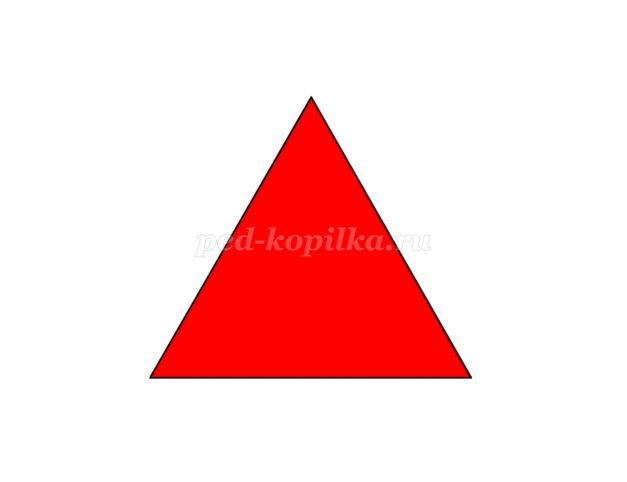
We put a triangle. This is the roof of our house. 3. We stretched the square and presented it to the eye, Who did it look like or something very similar? Not a brick, not a triangle - Became a square... (rectangle)

Let's create a rectangle. This will be the pipe for our house. — What else is missing in our house? (doors and windows) 4. I have no corners And I look like a saucer, Like a medal, like a pancake, Like an aspen leaf. I am an old friend to people. They call me (circle)
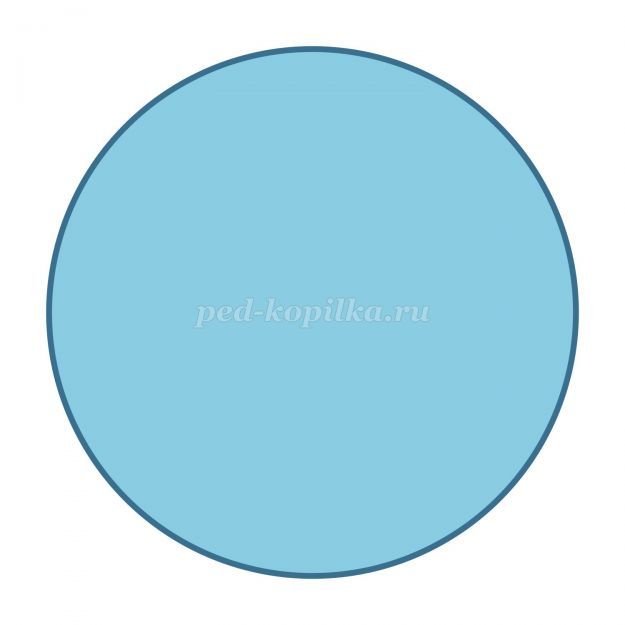
Let's make a circle. Guys, let's take two circles, these will be our windows. 5. Trace the whole brick with chalk on the asphalt, And you will get a figure - You, of course, are familiar with it. (Rectangle)

Let's create a rectangle. This will be the door for our house. Let's see what we got
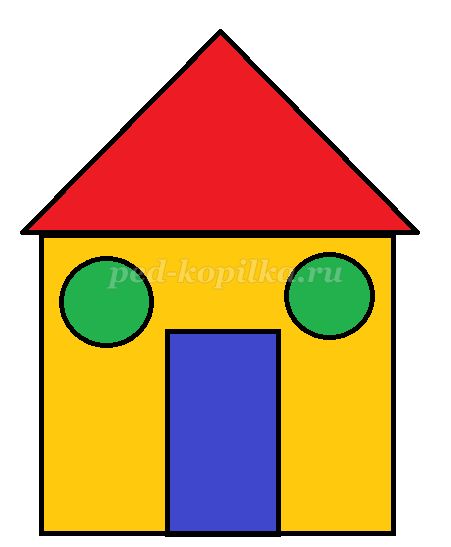
We recommend watching:
Summary of GCD for children of the preparatory group. How to be able to count well Mathematics lesson in the preparatory group. Notes Notes of the final lesson in mathematics in the preparatory group Notes of OD on FEMP in the preparatory group “Journey into the world of mathematics”
Similar articles:
Summary of mathematics lessons in the preparatory group. Pentagon
Summary of mathematics lessons in the preparatory group. Repetition of what has been learned in the senior group
Abstract of GCD in mathematics in the preparatory group. Solving logical problems
Abstract of GCD in mathematics in the preparatory group on the topic: Area
Abstract of GCD in mathematics in the preparatory group. Tangram
Game lesson in mathematics in the preparatory group. Author: teacher Sorokina O.V.
Software tasks:
1. Create conditions for identifying knowledge on the formation of elementary mathematical concepts in children in the preparatory group for school, organize joint activities of children.
2.Identify skills:
- relate quantity to number,
- make a number from two smaller numbers,
- navigate on a sheet of paper,
- compose and solve addition and subtraction problems,
- increase and decrease a number by one, two, three.
3. Strengthen children’s ability to compose simple arithmetic problems and solve problems; practice counting backwards and comparing numbers.
4. Create conditions for the development of logical thinking, attention, and intelligence.
5.Consolidate knowledge of the number series and sequence.
6. To develop children’s communication skills in joint activities, the ability to listen and hear each other and the teacher’s instructions, and to complete the task.
7. Foster independence, the ability to understand a learning task and carry it out independently. Increase interest in math classes.
Materials: envelopes - letters from the Queen of the country "Mathematics", cards for composing problems, cards with written tasks, simple and colored pencils.
Progress of the lesson
Organizational point: Guys, today we have an unusual activity. This morning I found these envelopes on the table. Who do you think they are from and what is in them? (children's answers 2-3). Guys, I'll give you a little hint. The Queen of the country “Mathematics” would like to invite you to visit, to take a short trip with her through this amazing country of numbers, numbers, and logic. Well, I don’t think this invitation will scare you. After all, you and I have learned a lot in our math classes. Guys, do we accept the invitation?
Task 1. I open the 1st envelope .
“To go on a trip, I suggest doing a “mathematical warm-up”: try to disenchant my math ball.”
Guys, the Queen of the country “Mathematics” offers to play the game “Enchanted Ball”. Stand in a circle. The math ball is enchanted to +2, -2, -1+ 3, -3, etc. Well done, you are simply magicians. And now I invite you to take a seat at the tables to open the next envelopes. Sit down, remember to follow rule 1, 2, 3.
Task 2. I open the 2nd envelope .
“To quickly get to the island of Mathematical Riddles, you will need transport. It needs to be built. Complete the following tasks."
Exercise “Auditory-motor dictation”: 2 cells down, 2 left, 2 down, 6 right, 2 up, 2 left, 2 up, 2 left (work on a sheet of checkered paper).
- What happened? (car).
- So, what will we go on? (by car). We start the engine: count down from 10 - along the chain.
- Here we are in the city! The next task is in the same envelope.
“Find the neighbors of the number and fill in the missing numbers in the empty cells.” Educator: Check each other’s sheets of assignments to see if your neighbor completed the assignment correctly. Well done! Well, shall we open the next envelope?
Task 3. Envelope 3.
“Guys, the inhabitants of my country - the “numbers” - have become new settlers. Each number has its own home, but they need to be helped to settle properly. because I really love order! Help move the residents by floor so that two numbers together make up a number corresponding to the house number “(Hand out pieces of paper). Let's continue our journey. Let's open the next envelope.
Task 4. Envelope 4.
“I’m interested to know how you solve problems. Listen carefully to this problem: five kittens, and a mother cat. How many cats are there on the window? “This task is not at all difficult for us. We can not only solve problems, but also invent and write them ourselves. Guys, you have cards with pictures on your table. Make up the conditions of the problem based on them and solve it (make up a problem based on the card and tell it: ask 2 or 3 children to comment).
Fizminutka:
Guys, I suggest you take a little rest. Leave the tables. Get comfortable. I will show the number, and you listen carefully to the task:
- 3 - clap one more. Children clap. How many times did you clap? Why?
- 4 - jump one more.
- 5 - sit down one less. How many times have you squatted? Why?
- 6 - raise your hands this many times.
- 1 - stomp one less. Why didn't you do anything?
Open the next envelope.
Task 5. Envelope 5.
“Well done, you know how to write problems. Now solve these examples. How much will it be if to 5+ 4=, 7+2=, 10-3=, 2+3= “.
Guys, I am pleased with your answers, you coped with this task. Go ahead. Open the next envelope.
Task 6. Envelope 6.
“I wrote numbers in a column for you. Compare them and write between them the corresponding signs “greater than”, “less than”, “equal to “. There are a lot of tasks, they are different for everyone and it’s not easy to solve them, but I think you can handle it “(work on pieces of paper). Educator: Well done: all the signs were placed correctly.
Task 7. Envelope 7.
“Guys, I really like to joke and have fun. I have a special task for you: mathematical problems are not simple, but with a trick. Listen carefully". Remember the rule: if you want to answer, don’t make any noise, just raise your hand.
1. There are 6 large cones and 2 small ones on the birch tree. How many cones are there on a birch tree?
2. The duck laid an egg. Who will hatch from it: a cockerel or a hen?
3. My sister is 4 years old, and my brother is 6 years old. How old will the brother be when his sister turns 6?
4. Spring has come, leaves began to fall from the trees. The wind carried them along the ground. What color were the leaves?
5. What are more on the field: daisies or flowers?
6. There are 4 corners in the room. There is a cat in every corner. There are 3 cats sitting opposite each cat. How many cats are there in the room?
We still have one envelope left unopened. Let's open it.
Task 7. Envelope 7.
“Guys, I am very pleased with your answers. I think that in school you will get excellent grades if you also do well on your assignments. I wish there were only “5” in your math diaries. Queen of the country "Mathematics".
Software tasks:
1. Create conditions for identifying knowledge on the formation of elementary mathematical concepts in children in the preparatory group for school, organize joint activities of children.
2.Identify skills:
- relate quantity to number,
- make a number from two smaller numbers,
- navigate on a sheet of paper,
- compose and solve addition and subtraction problems,
- increase and decrease a number by one, two, three.
3. Strengthen children’s ability to compose simple arithmetic problems and solve problems; practice counting backwards and comparing numbers.
4. Create conditions for the development of logical thinking, attention, and intelligence.
5.Consolidate knowledge of the number series and sequence.
6. To develop children’s communication skills in joint activities, the ability to listen and hear each other and the teacher’s instructions, and to complete the task.
7. Foster independence, the ability to understand a learning task and carry it out independently. Increase interest in math classes.
Materials: envelopes - letters from the Queen of the country "Mathematics", cards for composing problems, cards with written tasks, simple and colored pencils.
Progress of the lesson
Organizational point: Guys, today we have an unusual activity. This morning I found these envelopes on the table. Who do you think they are from and what is in them? (children's answers 2-3). Guys, I'll give you a little hint. The Queen of the country “Mathematics” would like to invite you to visit, to take a short trip with her through this amazing country of numbers, numbers, and logic. Well, I don’t think this invitation will scare you. After all, you and I have learned a lot in our math classes. Guys, do we accept the invitation?
Task 1. I open the 1st envelope .
“To go on a trip, I suggest doing a “mathematical warm-up”: try to disenchant my math ball.”
Guys, the Queen of the country “Mathematics” offers to play the game “Enchanted Ball”. Stand in a circle. The math ball is enchanted to +2, -2, -1+ 3, -3, etc. Well done, you are simply magicians. And now I invite you to take a seat at the tables to open the next envelopes. Sit down, remember to follow rule 1, 2, 3.
Task 2. I open the 2nd envelope .
“To quickly get to the island of Mathematical Riddles, you will need transport. It needs to be built. Complete the following tasks."
Exercise “Auditory-motor dictation”: 2 cells down, 2 left, 2 down, 6 right, 2 up, 2 left, 2 up, 2 left (work on a sheet of checkered paper).
- What happened? (car).
- So, what will we go on? (by car). We start the engine: count down from 10 - along the chain.
- Here we are in the city! The next task is in the same envelope. “Find the neighbors of the number and fill in the missing numbers in the empty cells.”
Educator: Check each other’s sheets of assignments to see if your neighbor completed the assignment correctly. Well done! Well, shall we open the next envelope?
Task 3. Envelope 3.
“Guys, the inhabitants of my country - the “numbers” - have become new settlers. Each number has its own home, but they need to be helped to settle properly. because I really love order! Help move the residents by floor so that two numbers together make up a number corresponding to the house number “(Hand out pieces of paper). Let's continue our journey. Let's open the next envelope.
Task 4. Envelope 4.
“I’m interested to know how you solve problems. Listen carefully to this problem: five kittens, and a mother cat. How many cats are there on the window? “This task is not at all difficult for us. We can not only solve problems, but also invent and write them ourselves. Guys, you have cards with pictures on your table. Make up the conditions of the problem based on them and solve it (make up a problem based on the card and tell it: ask 2 or 3 children to comment).
Fizminutka:
Guys, I suggest you take a little rest. Leave the tables. Get comfortable. I will show the number, and you listen carefully to the task:
- 3 - clap one more. Children clap. How many times did you clap? Why? - 4 - jump one more.
- 5 - sit down one less. How many times have you squatted? Why?
- 6 - raise your hands this many times.
- 1 - stomp one less. Why didn't you do anything?
Open the next envelope.
Task 5. Envelope 5.
“Well done, you know how to write problems. Now solve these examples. How much will it be if to 5+ 4=, 7+2=, 10-3=, 2+3= “.
Guys, I am pleased with your answers, you coped with this task. Go ahead. Open the next envelope.
Task 6. Envelope 6.
“I wrote numbers in a column for you. Compare them and write between them the corresponding signs “greater than”, “less than”, “equal to “. There are a lot of tasks, they are different for everyone and it’s not easy to solve them, but I think you can handle it “(work on pieces of paper). Educator: Well done: all the signs were placed correctly.
Task 7. Envelope 7.
“Guys, I really like to joke and have fun. I have a special task for you: mathematical problems are not simple, but with a trick. Listen carefully". Remember the rule: if you want to answer, don’t make any noise, just raise your hand.
1. There are 6 large cones and 2 small ones on the birch tree. How many cones are there on a birch tree?
2.The duck laid an egg. Who will hatch from it: a cockerel or a hen?
3. My sister is 4 years old, and my brother is 6 years old. How old will the brother be when his sister turns 6?
4. Spring has come, leaves began to fall from the trees. The wind carried them along the ground. What color were the leaves?
5. What are more on the field: daisies or flowers?
6. There are 4 corners in the room. There is a cat in every corner. There are 3 cats sitting opposite each cat. How many cats are there in the room?
We still have one envelope left unopened. Let's open it.
Task 7. Envelope 7.
“Guys, I am very pleased with your answers. I think that in school you will get excellent grades if you also do well on your assignments. I wish there were only “5” in your math diaries. Queen of the country "Mathematics".
